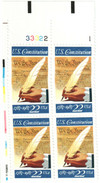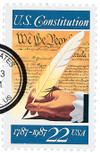
# 2360 - 1987 22c Signing of the Constitution
U.S. #2360
1987 22¢ Signing of the Constitution
- Issued on 200th anniversary of the signing of the US Constitution
- Pictures the Preamble to the Constitution
Stamp Category: Commemorative
Value: 22¢, first-class rate
First Day of Issue: September 17, 1987
First Day City: Philadelphia, Pennsylvania
Quantity Issued: 168,995,000
Printed by: Bureau of Engraving and Printing
Printing Method: Lithographed and Engraved
Format: Panes of 50 in sheets of 200
Perforations: 11
Why the stamp was issued: To commemorate the 200th anniversary of the signing of the US Constitution.
About the stamp design: Howard Koslow submitted five different versions of his design for this stamp, in both horizontal and vertical formats. They all featured variations of the same theme – a hand holding a quill pen, and most included the Constitution in the background. It was that arrangement the USPS ultimately selected.
Although the stamp shows the preamble of the US Constitution and a hand signing, it was actually the fourth page of the document that was signed. Since the preamble is the most recognizable section, the decision was made to include it in the stamp design.
About the printing process: Black intaglio was used for the tiny handwriting on the Constitution. An engraver at the BEP said he thought it was some of the “tiniest, finest engraving seen on US stamps in recent years.”
First Day City: The First Day ceremony for this stamp was held in Philadelphia, Pennsylvania as part of the city’s three-day “We the People 200” celebration. Activities included a $3.5 million parade with Pony Express riders and 20,000 participants. The First Day ceremony was one of the USPS’s most brief, at just 103 words, and less than a minute.
Unusual fact about this stamp: At least one known error stamp has been found with the black engraving omitted.
History the stamp represents: On September 17, 1787, 39 delegates from 12 states signed the U.S. Constitution, laying the groundwork of our nation’s government.
In the Spring of 1787, delegates from 12 of the 13 states (Rhode Island didn’t participate, they opposed a national government) met at Independence Hall in Philadelphia to amend the Articles of Confederation. The Constitutional Convention was set to open on May 4, but few of the delegates had arrived by that time. Though, one arrived early and eager – James Madison.
Madison was ready to share and implement his ideas to improve to the U.S. government. He arrived at the convention with a number of resources to share with his fellow delegates. Madison brought a paper on early and modern confederacies, and another explaining what he considered the strengths and weaknesses of the Articles of Confederation. His plan was to create a new central government with stronger powers, an elected chief executive with the power to veto legislation, a federal judiciary branch, and a two-chambered legislature. While each branch would have certain set responsibilities, they would each also have the opportunity to take part in checks and balances of each other’s actions.
Madison’s plan was an overwhelming success. The members of the convention drafted the new constitution based largely on his ideas and signed it on September 17, replacing the Articles of Confederation. In addition, he shared his Virginia Plan, which consisted of a House of Representatives (with the members from each state dependent on population) and a Senate (whose delegates would be elected by the House of Representatives) was utilized as the national hierarchy with one change. In the final plan, the number of Senators from each state would be the same, which differed slightly from Madison’s vision.
In order for the proposed constitution to take effect, at least nine out of 13 states needed to ratify it. Madison lobbied extensively to ensure the constitution’s passage. Along with Alexander Hamilton and John Jay, Madison published a series of 85 essays called “The Federalist Papers.” They explained in detail how the constitution would work. Madison is credited with writing 26 of these essays. Despite opposing arguments from Patrick Henry, James Monroe, and George Mason, the constitution was ratified by each state by 1790. The U.S. Constitution was now the supreme law of America.
U.S. #2360
1987 22¢ Signing of the Constitution
- Issued on 200th anniversary of the signing of the US Constitution
- Pictures the Preamble to the Constitution
Stamp Category: Commemorative
Value: 22¢, first-class rate
First Day of Issue: September 17, 1987
First Day City: Philadelphia, Pennsylvania
Quantity Issued: 168,995,000
Printed by: Bureau of Engraving and Printing
Printing Method: Lithographed and Engraved
Format: Panes of 50 in sheets of 200
Perforations: 11
Why the stamp was issued: To commemorate the 200th anniversary of the signing of the US Constitution.
About the stamp design: Howard Koslow submitted five different versions of his design for this stamp, in both horizontal and vertical formats. They all featured variations of the same theme – a hand holding a quill pen, and most included the Constitution in the background. It was that arrangement the USPS ultimately selected.
Although the stamp shows the preamble of the US Constitution and a hand signing, it was actually the fourth page of the document that was signed. Since the preamble is the most recognizable section, the decision was made to include it in the stamp design.
About the printing process: Black intaglio was used for the tiny handwriting on the Constitution. An engraver at the BEP said he thought it was some of the “tiniest, finest engraving seen on US stamps in recent years.”
First Day City: The First Day ceremony for this stamp was held in Philadelphia, Pennsylvania as part of the city’s three-day “We the People 200” celebration. Activities included a $3.5 million parade with Pony Express riders and 20,000 participants. The First Day ceremony was one of the USPS’s most brief, at just 103 words, and less than a minute.
Unusual fact about this stamp: At least one known error stamp has been found with the black engraving omitted.
History the stamp represents: On September 17, 1787, 39 delegates from 12 states signed the U.S. Constitution, laying the groundwork of our nation’s government.
In the Spring of 1787, delegates from 12 of the 13 states (Rhode Island didn’t participate, they opposed a national government) met at Independence Hall in Philadelphia to amend the Articles of Confederation. The Constitutional Convention was set to open on May 4, but few of the delegates had arrived by that time. Though, one arrived early and eager – James Madison.
Madison was ready to share and implement his ideas to improve to the U.S. government. He arrived at the convention with a number of resources to share with his fellow delegates. Madison brought a paper on early and modern confederacies, and another explaining what he considered the strengths and weaknesses of the Articles of Confederation. His plan was to create a new central government with stronger powers, an elected chief executive with the power to veto legislation, a federal judiciary branch, and a two-chambered legislature. While each branch would have certain set responsibilities, they would each also have the opportunity to take part in checks and balances of each other’s actions.
Madison’s plan was an overwhelming success. The members of the convention drafted the new constitution based largely on his ideas and signed it on September 17, replacing the Articles of Confederation. In addition, he shared his Virginia Plan, which consisted of a House of Representatives (with the members from each state dependent on population) and a Senate (whose delegates would be elected by the House of Representatives) was utilized as the national hierarchy with one change. In the final plan, the number of Senators from each state would be the same, which differed slightly from Madison’s vision.
In order for the proposed constitution to take effect, at least nine out of 13 states needed to ratify it. Madison lobbied extensively to ensure the constitution’s passage. Along with Alexander Hamilton and John Jay, Madison published a series of 85 essays called “The Federalist Papers.” They explained in detail how the constitution would work. Madison is credited with writing 26 of these essays. Despite opposing arguments from Patrick Henry, James Monroe, and George Mason, the constitution was ratified by each state by 1790. The U.S. Constitution was now the supreme law of America.











